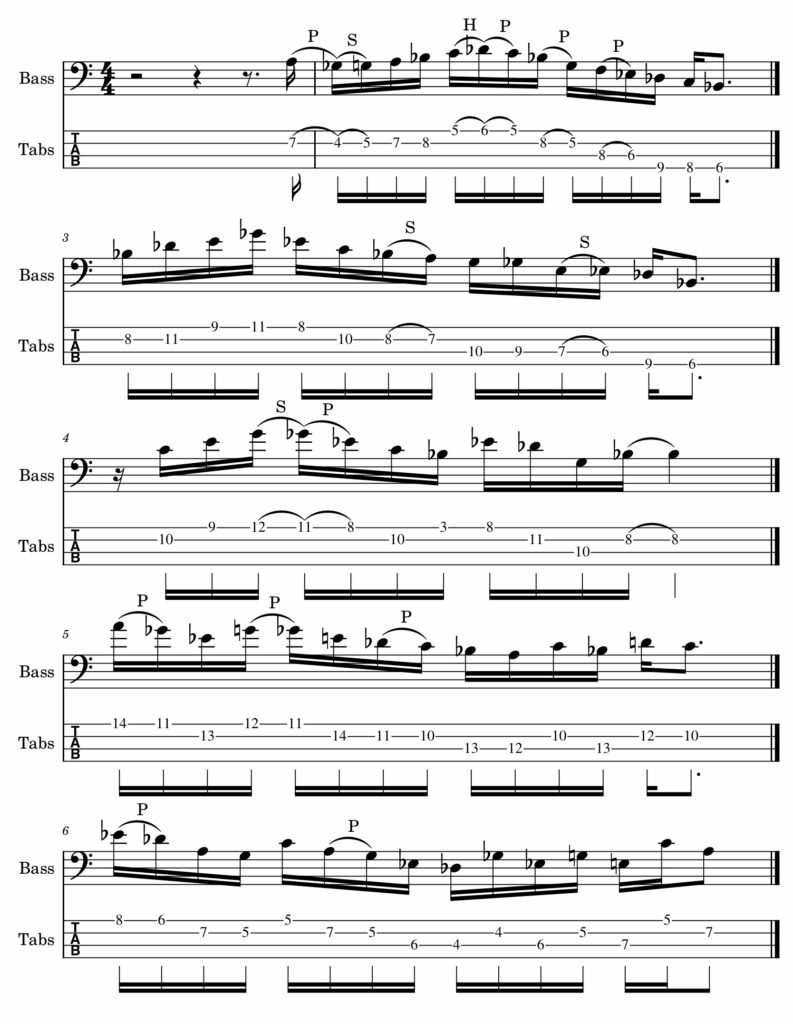The diminished harmony is a versatile tool that can add a unique flavour to your bass playing. In this post, we’ll explore what diminished chords are, how to use them and what you can play over them.
What Are Diminished Chords?
These unique chords consist of a sequence of minor thirds that divide the octave into four equal parts. Let’s break down a C diminished chord: Root (C), Flat 3 (Eb), Flat 5 (Gb) and Double Flat 7 (Bbb, which is equivalent to A).
Diminished chords are typically noted with symbols like “dim” and “°”. It’s essential to distinguish them from half-diminished chords as they differ in quality. What’s fascinating about diminished chords is their symmetrical nature, for example, C° shares the same notes as Eb°, F#°, and A°.
How and Where Are They Used?
1. Substitutions for Dominant Chords: Diminished chords can be used as substitutions for dominant chords and dominant chords can be seen as a diminished chord over the root. Since the diminished chord contains the essential tritone, it serves the same purpose as a dominant chord. For example, C° can resolve to E, G, Bb, or Db.
2. Chromatic Passing Chords: Diminished chords are used in place of V7b9 chords to create a chromatic movement within the progressions. For example, a sequence like CMaj, A7b9, D-7 can be replaced by CMaj, C#°, D-7, adding a chromatic element to the bass line.
The Diminished Scale
The diminished scale comes in two forms: alternating half steps and whole steps or vice versa. Both forms contain the same notes, offering two modes to explore. The diminished scale harmony lacks avoid notes making everything within the scale interchangeable, including licks, phrases, patterns, and more.
In summary:
- Use the T/S diminished scales for diminished chords.
- The S/T version for dominant chords.
- The T/S scale for minor chords, which is identical to the S/T from the V7.
- Over major chords, use the S/T from the 5th and the T/S from the root.
Enhancing Your Fills
When it comes to developing your bass fills and phrases, incorporating various exercises and concepts is key. Pick a groove and focus on applying diminished exercises to enhance your fills and create exciting variations. Remember, learning new concepts requires time and repetition, but the payoff is the freedom to incorporate new sounds into your playing.
1. Diminished Arpeggios
Begin by practicing diminished arpeggios. Ascend and descend through the arpeggio, highlighting the characteristic intervals of the diminished chord (root, minor third, flat five). Then, experiment with various rhythmic variations.
2. Chromatic Approaches
Use chromatic approaches to add tension. Approach target chords for creating a sense of anticipation and resolution. Try different positions on the fretboard to explore various melodic options.
3. Diminished Scale Runs
To make your fills more exciting add diminished scale runs, try both ascending and descending runs. Don’t forget to mix these runs with different rhythms too.
Dedicate yourself to practicing these concepts regularly. As you become comfortable with these fills, you will develop the freedom to incorporate them into your playing. Diminished chords may seem complex, but they hold great potential. Now that you have a clearer understanding of diminished harmony, it’s time to practice.
When I decided to work on diminished harmony I started by practising the diminished scale for a month straight, you have only 3 keys: C, C# and D. Pick one and start to apply all the exercises. The diminished Harmony is covered on the Fret Trainer ebook along some other hip harmony tips.
Get Started, Try Some Diminished Licks Over C7.

Fret Trainer Ebook
Fret Trainer eBook – BassAdvice 📘 Page Count: 68 pages of in-depth bass fretboard mastery 📥 Digital Download: Immediate access to your eBook PDF 🎶 Focus on Notations: Master the fretboard and maintain your reading skills with musical notations—ideal for those looking to deepen their understanding of music theory and application. 📚 Explore: Gain comprehensive…

